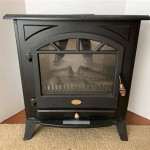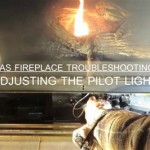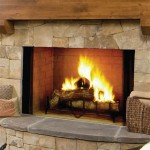Paint for Inside of a Gas Fireplace: A Comprehensive Guide
Gas fireplaces offer a convenient and efficient alternative to traditional wood-burning hearths. Their ease of use and consistent heat output make them a popular choice for homeowners seeking supplemental heating and aesthetic ambiance. However, like any appliance, the interior components of a gas fireplace can degrade over time, often manifesting as discoloration, rust, or general wear and tear on the refractory materials. This degradation can detract from the fireplace's visual appeal and, in some cases, impact its performance. Therefore, selecting the appropriate paint for the inside of a gas fireplace is crucial for maintaining its appearance and functionality.
The interior of a gas fireplace is subjected to high temperatures generated by the burning gas. Therefore, standard paints designed for general household use are unsuitable. These paints are not formulated to withstand extreme heat and can melt, bubble, emit noxious fumes, and even become a fire hazard. Consequently, only specialized high-temperature paints specifically designed for fireplace applications should be used.
These specialized paints are typically formulated with heat-resistant resins and pigments that can withstand sustained temperatures ranging from 1200°F (649°C) to 2000°F (1093°C), depending on the specific product. These paints also adhere well to common fireplace materials such as firebrick, refractory panels, and metal components. Proper preparation and application are essential to ensure the paint's longevity and performance.
Key Considerations When Choosing Paint
Selecting the correct paint involves several crucial considerations to ensure compatibility, safety, and desired aesthetic outcome. Several factors must be evaluated before making a purchase.
1. Heat Resistance: The primary factor is the paint's heat resistance rating. This rating indicates the maximum temperature the paint can withstand without degrading or releasing harmful fumes. The required heat resistance will depend on the specific gas fireplace model and its BTU (British Thermal Unit) output, which determines the amount of heat generated. Consult the fireplace manufacturer's specifications or a qualified fireplace technician to determine the appropriate heat resistance rating for the paint. It is always prudent to err on the side of caution and choose a paint with a slightly higher heat resistance rating than the minimum requirement.
2. Substrate Compatibility: Gas fireplaces often incorporate different materials in their interior construction, including firebrick, refractory panels (made from ceramic fiber or vermiculite), and metal components such as burner tubes and control boxes. The chosen paint must be compatible with all the materials to which it will be applied. Some paints are formulated for specific substrates, while others are designed for universal application. Refer to the paint manufacturer's product information to ensure compatibility with the fireplace's interior materials. Using an incompatible paint can result in poor adhesion, cracking, peeling, and ultimately, paint failure.
3. Paint Type and Formulation: High-temperature paints for fireplaces are typically available in two primary formulations: solvent-based and water-based. Solvent-based paints generally offer superior heat resistance and durability compared to water-based paints. However, they tend to emit stronger fumes during application and require proper ventilation. Water-based paints are lower in VOCs (volatile organic compounds) and easier to clean up, but may not offer the same level of heat resistance or longevity. The choice between solvent-based and water-based paints depends on individual preferences, ventilation capabilities, and the specific requirements of the gas fireplace. Certain paints may also contain additives to improve adhesion, prevent rust, or enhance the finish.
Preparing the Fireplace for Painting
Proper preparation is paramount to achieving a durable and aesthetically pleasing paint finish. Neglecting this step can lead to paint failure, peeling, and compromised appearance. The preparation process typically involves several key stages.
1. Safety Precautions: Before commencing any work, ensure the gas supply to the fireplace is completely shut off. Allow the fireplace to cool down completely before proceeding. Wear appropriate personal protective equipment (PPE), including gloves, eye protection, and a respirator to avoid inhaling dust and fumes. Work in a well-ventilated area, especially when using solvent-based paints.
2. Cleaning and Degreasing: Thoroughly clean the interior surfaces of the fireplace to remove any dirt, dust, soot, grease, or loose debris. Use a stiff brush, vacuum cleaner, and mild detergent solution to clean the surfaces. Stubborn stains or residue may require a specialized fireplace cleaner. Rinse the surfaces thoroughly with clean water and allow them to dry completely before proceeding. Degreasing is particularly important if the fireplace has accumulated grease or oil from cooking or other sources. Grease can prevent the paint from adhering properly to the surface.
3. Surface Preparation: Depending on the condition of the existing surfaces, some additional preparation may be necessary. Remove any loose or flaking paint with a scraper or wire brush. Lightly sand smooth, glossy surfaces to create a better adhesion surface for the new paint. Repair any cracks or chips in the firebrick or refractory panels with a high-temperature patching compound specifically designed for fireplace repairs. Allow the patching compound to cure completely according to the manufacturer's instructions before painting.
4. Masking and Protection: Protect surrounding areas from overspray by masking off any areas that should not be painted, such as the fireplace surround, glass door, and control panel. Use painter's tape and drop cloths to create a clean and protected workspace. This will prevent unwanted paint from getting on adjacent surfaces and simplify the cleanup process.
Application Techniques for High-Temperature Paint
Applying high-temperature paint requires a specific technique to ensure a uniform, durable, and long-lasting finish. Following the manufacturer's instructions carefully is imperative.
1. Priming (Optional): Some high-temperature paints may require the application of a primer to improve adhesion and provide a more uniform base for the topcoat. If a primer is recommended, use a high-temperature primer specifically designed for fireplace applications. Apply the primer in thin, even coats, allowing it to dry completely between coats according to the manufacturer's instructions.
2. Application Method: High-temperature paints can be applied using various methods, including aerosol spray cans, brushes, or spray guns. Aerosol spray cans are convenient for small touch-up jobs and intricate areas. Brushes are suitable for larger surfaces and allow for more precise application. Spray guns provide the most uniform finish but require specialized equipment and expertise. Regardless of the application method, apply the paint in thin, even coats to avoid runs, drips, and sagging. Multiple thin coats are preferable to a single thick coat.
3. Drying and Curing: Allow the paint to dry completely between coats according to the manufacturer's instructions. The drying time will vary depending on the paint type, temperature, and humidity. After applying the final coat, allow the paint to cure completely before using the fireplace. Curing is the process by which the paint reaches its maximum hardness and heat resistance. The curing time can range from several hours to several days. Some high-temperature paints require a heat curing process, which involves gradually increasing the temperature of the fireplace to a specific level over a period of time. This process helps to fully harden the paint and improve its adhesion. Refer to the paint manufacturer's instructions for specific drying and curing recommendations.
4. Ventilation: Ensure adequate ventilation throughout the entire painting and drying process. Open windows and doors to allow fresh air to circulate. Use a fan to further improve ventilation. This is particularly important when using solvent-based paints, which emit strong fumes. Avoid breathing the fumes, and take breaks to get fresh air as needed.
5. Cleaning Up: Clean up any spills or overspray immediately with a solvent-based cleaner or soap and water, depending on the paint type. Dispose of used paint cans, brushes, and rollers properly according to local regulations. Store leftover paint in a tightly sealed container in a cool, dry place away from heat and flames.
By carefully considering these factors, preparing the fireplace properly, and applying the paint according to the manufacturer's instructions, homeowners can effectively restore the appearance of their gas fireplace and ensure its continued performance and safety.

How To Paint The Inside Of A Fireplace Simple Upgrade Maria Louise Design

How To Spray Paint Fireplace Interior The Diy Playbook

Fireplace Makeover Spray Paint Magic

Fireplace Makeover Spray Paint Magic

What Kind Of Paint To Use On The Inside A Fireplace Hunker

Fireplace Makeover Spray Paint Magic

Paint Inside Of Your Fireplace South House Designs

Painting The Interior Of A Fireplace Shine Your Light

Diy Fireplace Makeover With High Heat Paint Jessica Welling Interiors

How To Paint The Inside Of A Fireplace Sarah Joy








